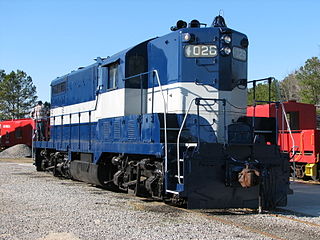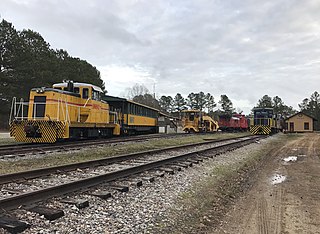
The East Carolina Railway was a short-line railroad that ran from 1898 to 1965. Originating in Tarboro, North Carolina the East Carolina Railway interchanged at Farmville, North Carolina with the original Norfolk Southern Railway.

The East Carolina Railway was a short-line railroad that ran from 1898 to 1965. Originating in Tarboro, North Carolina the East Carolina Railway interchanged at Farmville, North Carolina with the original Norfolk Southern Railway.
The East Carolina Railway was incorporated in Tarboro in 1898, organized and initially presided over by Henry Clark Bridgers, Sr., nephew of Robert Rufus Bridgers who was president of the Wilmington and Weldon Railroad. Constructed using prison labor from Raleigh, the tracks reached Pinetops, North Carolina by July 1900, Macclesfield, North Carolina by September 1900, and in 1901 it extended all the way to Farmville. In 1908, the line was extended 12 miles to Hookerton, North Carolina. This segment was abandoned in 1933 during the Great Depression. [1]
The railroad was acquired by the Atlantic Coast Line Railroad (ACL) in 1935, but continued to be locally managed by Henry Clark Bridgers until his death in 1951. The railway continued to be operated under the East Carolina Railway name until the Atlantic Coast Line Railroad abandoned the line in 1965. The last train ran on 16 November 1965. [1]
In 1960, East Carolina reported 1.1 million net ton-miles of revenue freight and no passengers on its 29-mile railroad.[ citation needed ]
The operating schedule as of 10 November 1903, according to the August 1904 edition of the "Official Guide of the Railways and Steam Navigation Lines of the United States, Porto Rico [sic], Canada, Mexico and Cuba" showed the departure of a train from Tarboro at 9:40 a.m. Eastern time, arriving at Farmville, 26 miles away, at 11:25 a.m. on Monday-Tuesday, and Thursday-Friday. On Wednesday and Saturday, the departure was at 3:35 p.m. with arrival at 5:50 p.m. Return trips departed at 6:45 a.m. Monday-Tuesday, Thursday-Friday, with arrival at 9:05 a.m., and at 12:30 p.m., arriving 2:30 p.m., on Wednesday and Saturday. No service ran on Sunday. [2]
Around 1913, the East Carolina Railroad acquired seven single-truck streetcars, two closed motor (nos. 531 and 563) and five closed trailers (1514, 1521, 1526, 1552, and 1554) after they were retired by the Capital Traction Company in Washington, D.C. They were rebuilt in the Tarboro shops as gasoline-powered motor cars for passenger use, and saw about 17 years of service. [3]
The last steam operation on the line was by ACL Baldwin Locomotive 4-6-0, No. 1031, in April 1957, now on display at the North Carolina Transportation Museum in Spencer, N.C. [4]

A heritage railway or heritage railroad is a railway operated as living history to re-create or preserve railway scenes of the past. Heritage railways are often old railway lines preserved in a state depicting a period in the history of rail transport.

The Norfolk Southern Railway is a Class I freight railroad operating in the Eastern United States. Headquartered in Atlanta, the company was formed in 1982 with the merger of the Norfolk and Western Railway and Southern Railway. The company operates 19,420 route miles (31,250 km) in 22 eastern states, the District of Columbia, and has rights in Canada over the Albany to Montreal route of the Canadian Pacific Kansas City. Norfolk Southern Railway is the leading subsidiary of the Norfolk Southern Corporation.

The interurban is a type of electric railway, with tram-like electric self-propelled rail cars which run within and between cities or towns. The term "interurban" is usually used in North America, with other terms used outside it. They were very prevalent in many parts of the world before the Second World War and were used primarily for passenger travel between cities and their surrounding suburban and rural communities. Interurban as a term encompassed the companies, their infrastructure, their cars that ran on the rails, and their service. In the United States, the early 1900s interurban was a valuable economic institution, when most roads between towns, many town streets were unpaved, and transportation and haulage was by horse-drawn carriages and carts.

U.S. Route 258 is a spur of US 58 in the U.S. states of North Carolina and Virginia. The U.S. Highway runs 220.15 miles (354.30 km) from US 17 Business and NC 24 Business in Jacksonville, North Carolina north to Virginia State Route 143 at Fort Monroe in Hampton, Virginia. In North Carolina, US 258 connects Jacksonville with the Inner Banks communities of Kinston, Snow Hill, Farmville, Tarboro, and Murfreesboro. The U.S. Highway continues through the Virginia city of Franklin, where the highway intersects US 58, and the town of Smithfield on its way to the Hampton Roads metropolitan area. US 258 crosses the James River on the James River Bridge and follows Mercury Boulevard through Newport News and Hampton.

U.S. Route 264 (US 264) is an east–west United States Highway located completely within the U.S. state of North Carolina, running for 215.7 miles (347.1 km). Its western terminus is located at Interstate 87 (I-87), I-440, and US 64 in Raleigh. US 264 is a freeway between Raleigh and Wilson, with segments running concurrently with I-87, I-587, I-795, and US 64. The highway is largely parallel to I-587 between Wilson and Greenville and primarily serves smaller communities such as Saratoga and Farmville. East of Greenville, US 264 is an important highway connecting communities such as Washington, Belhaven, Swan Quarter, and Engelhard. The eastern terminus of US 264 is located at US 64 in Manns Harbor.

The Atlantic Coast Line Railroad was a United States Class I railroad formed in 1900, though predecessor railroads had used the ACL brand since 1871. In 1967, it merged with long-time rival Seaboard Air Line Railroad to form the Seaboard Coast Line Railroad. Much of the original ACL network has been part of CSX Transportation since 1986.

The Georgia Railroad and Banking Company also seen as "GARR", was a historic railroad and banking company that operated in the U.S. state of Georgia. In 1967 it reported 833 million revenue-ton-miles of freight and 3 million passenger-miles; at the end of the year it operated 331 miles (533 km) of road and 510 miles (820 km) of track.

The North Carolina Transportation Museum is a museum in Spencer, North Carolina. It is a collection of automobiles, aircraft, and railway vehicles. The museum is located at the former Southern Railway's 1896-era Spencer Shops and devotes much of its space to the state's railroad history. The museum has the largest collection of rail relics in the Carolinas. Its Back Shop building of nearly three stories high is notable for its size, two football fields long.

The Illinois Terminal Railroad Company, known as the Illinois Traction System until 1937, was a heavy duty interurban electric railroad with extensive passenger and freight business in central and southern Illinois from 1896 to 1956. When Depression era Illinois Traction was in financial distress and had to reorganize, the Illinois Terminal name was adopted to reflect the line's primary money making role as a freight interchange link to major steam railroads at its terminal ends, Peoria, Danville, and St. Louis. Interurban passenger service slowly was reduced, ending in 1956. Freight operation continued but was hobbled by tight street running in some towns requiring very sharp radius turns. In 1956, ITC was absorbed by a consortium of connecting railroads.

Streetcars in Washington, D.C. transported people across the city and region from 1862 until 1962.
The Wilmington and Weldon Railroad (W&W) name began use in 1855, having been originally chartered as the Wilmington and Raleigh Railroad in 1834. When it opened in 1840, the line was the longest railroad in the world with 161.5 miles (259.9 km) of track. It was constructed in 4 ft 8 in gauge. At its terminus in Weldon, North Carolina, it connected with the Seaboard and Roanoke Railroad and the Petersburg Railroad. The railroad also gave rise to the city of Goldsboro, North Carolina, the midpoint of the W&W RR and the railroad intersection with the North Carolina Railroad. It’s been more than 50 years since passenger rail linked Wilmington and Raleigh, but there’s a renewed push to bring back a passenger route between the two cities. The latest feasibility study, prepared by Florida-based firm WGI Inc., compares two potential route options linking Wilmington with Raleigh: a western route through Fayetteville and an eastern route through Goldsboro.

The Sacramento Northern Railway was a 183-mile (295 km) electric interurban railway that connected Chico in northern California with Oakland via the state capital, Sacramento. In its operation it ran directly on the streets of Oakland, Sacramento, Yuba City, Chico, and Woodland. This involved multiple car trains making sharp turns at street corners and obeying traffic signals. Once in open country, SN's passenger trains ran at fairly fast speeds. With its shorter route and lower fares, the SN provided strong competition to the Southern Pacific and Western Pacific Railroad for passenger business and freight business between those two cities. North of Sacramento, both passenger and freight business was less due to the small town agricultural nature of the region and due to competition from the paralleling Southern Pacific Railroad.

The New Hope Valley Railway is a heritage railroad in Bonsal, North Carolina operated by the North Carolina Railway Museum, Inc., an all-volunteer, nonprofit, and tax exempt educational and historical organization.
The Texas Transportation Company was an electrified, Class III, short-line railroad in San Antonio, Texas, that operated from 1897 until 2001. It served the Pearl Brewery and several other businesses, moving carloads between those businesses and the Southern Pacific yard. Service ended on June 30, 2000, shortly before the Pabst Brewing Company closed the Pearl Brewery, in early 2001.
The Piedmont & Northern Railway was a heavy electric interurban company operating over two disconnected divisions in North and South Carolina. Tracks spanned 128 miles (206 km) total between the two segments, with the northern division running 24 miles (39 km) from Charlotte, to Gastonia, North Carolina, including a three-mile (5 km) spur to Belmont. The southern division main line ran 89 miles (143 km) from Greenwood to Spartanburg, South Carolina, with a 12 mi (19 km) spur to Anderson. Initially the railroad was electrified at 1500 volts DC, however, much of the electrification was abandoned when dieselisation was completed in 1954.
Rail transportation is an important element of the transportation network in the U.S. state of Oregon. Rail transportation has existed in Oregon in some form since 1855, and the state was a pioneer in development of electric railway systems. While the automobile has displaced many uses of rail in the state, rail remains a key means of moving passengers and freight, both within the state and to points beyond its borders.
The Aurora, Elgin & Fox River Electric (AE&FRE), was an interurban railroad that operated freight and passenger service on its line paralleling the Fox River. It served the communities of Carpentersville, Dundee, Elgin, South Elgin, St. Charles, Geneva, Batavia, North Aurora, Aurora, Montgomery, and Yorkville in Illinois. It also operated local streetcar lines in both Aurora and Elgin.
The Portsmouth Subdivision is a railroad line owned by CSX Transportation in Virginia and North Carolina. The line connects CSX's network with the port city of Portsmouth, Virginia. The Portsmouth Subdivision was historically operated by the Seaboard Air Line Railroad, a CSX predecessor.
The W&W Subdivision is a railroad line owned by CSX Transportation in the U.S. state of North Carolina. The line today runs from just south of Wilson, North Carolina, to Wallace, North Carolina, for a total of 69.1 miles. At its north end the line connects to CSX's A Line. The line's name stands for the Wilmington and Weldon Railroad, the company that originally built the line.

Wilmington Union Station was a union station in Wilmington, North Carolina. Opened in 1913, it was designed by architect Joseph F. Leitner. Construction by Boyle-Robertson contractors began in 1912. It was located at Front Street and Red Cross Street in downtown Wilmington.